Welcome to our gardening blog, where we embark on a delightful journey of cultivating Marigolds in the cozy confines of your balcony pots! 🪴 In this guide, we will take you through the rewarding process of nurturing these vibrant and cheerful flowers, from the very beginning – sowing the seeds, to witnessing the breathtaking blooms. Marigolds, with their sun-kissed hues and distinct fragrance, have long been cherished as a beloved addition to any garden space.
And now, even if you have limited outdoor space, your balcony can transform into a haven of beauty and nature’s wonders. So, roll up your sleeves, gather your gardening tools, and let’s dive into the art of growing Marigolds, step by step, until your balcony flourishes with the vibrant colors of these delightful blooms. Let nature’s charm and your green thumb create a magical balcony oasis! 🌼🌞
Why Marigolds? Unraveling the Beauty and Benefits for Balcony Gardening
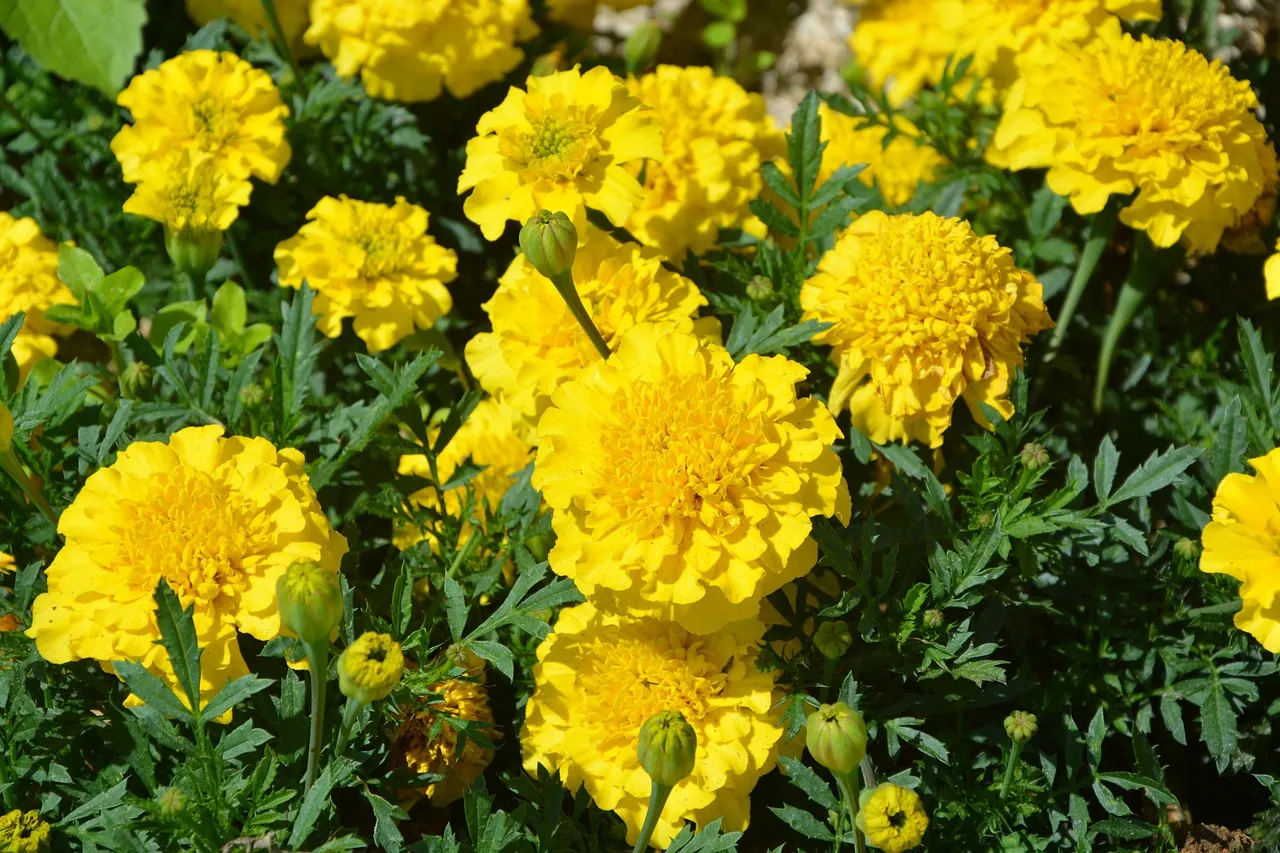
Marigolds are a true gem in the world of balcony gardening, offering both aesthetic charm and practical advantages. These vibrant blooms come in a dazzling array of colors, ranging from sunny yellows and fiery oranges to rich reds. Their stunning hues instantly brighten up any outdoor space, infusing it with a sense of joy and cheerfulness. Beyond their visual appeal, marigolds are highly beneficial for your balcony garden.
These hardy flowers are known for their pest-repelling properties, acting as a natural deterrent against common garden pests like aphids and mosquitoes. Additionally, marigolds attract pollinators such as bees and butterflies, fostering a healthier and more biodiverse environment on your balcony. Even beginner gardeners can easily cultivate marigolds, as they are low-maintenance and thrive in various climates.
By planting marigolds, you not only elevate the beauty of your balcony but also create a harmonious ecosystem that supports the growth of other plants. So, let’s delve into the captivating world of marigolds and uncover the many rewards they bring to your balcony garden!
Types of Marigold:
African Marigold (Tagetes erecta):

African marigolds are known for their large, showy blooms and vibrant colors, ranging from deep oranges and yellows to creamy whites. These tall and robust plants can reach heights of up to three feet, making them excellent focal points in balcony gardens. Their striking appearance adds a touch of elegance and grandeur to any outdoor space.
African marigolds thrive in full sunlight and prefer well-draining soil, making them ideal for balcony pots. With proper care and maintenance, African marigolds can produce an abundance of blooms throughout the growing season, dazzling with their radiant flower colors.
French Marigold (Tagetes patula):
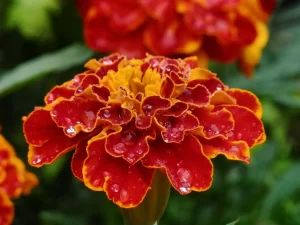
French marigolds are more compact than their African counterparts, making them perfect for smaller balcony spaces. Their blooms are equally striking, coming in a variety of colors, including vibrant oranges, yellows, and reds. These charming flowers also have a delightful scent that adds to the overall allure of your balcony garden.
French marigolds are well-adapted to various soil types and light conditions, but they thrive best in well-draining soil and full sunlight. Their versatility and low-maintenance nature make them popular choices for balcony gardening. With French marigolds adorning your balcony, you’ll have a stunning display of flower colors that captivate and inspire.
Signet Marigold (Tagetes tenuifolia):
Signet marigolds may be small, but their numerous blooms add charm to any balcony garden. Unlike other marigolds, they’re edible with a citrusy and peppery flavor, perfect for salads and desserts. They’re great companion plants, repelling pests and protecting neighboring plants. Ideal for containers and hanging baskets, they brighten up small balconies. With captivating flower colors and unique flavor, signet marigolds are sure to dazzle your taste buds and elevate your balcony’s beauty.
Mexican Marigold (Tagetes lucida):
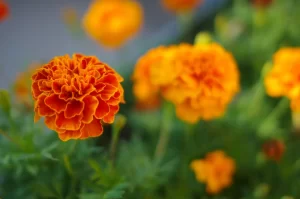
Mexican marigolds, also known as Mexican tarragon or sweet mace, are valued not only for their ornamental beauty but also for their culinary and medicinal uses. These marigolds have delicate, golden-yellow flowers and aromatic foliage that imparts a pleasant anise-like flavor. As a culinary herb, Mexican marigold is used to season a variety of dishes, while its medicinal properties are believed to aid digestion and soothe respiratory ailments.
In balcony gardens, Mexican marigolds add a unique and enchanting touch, both in appearance and flavor. These marigolds are relatively low-maintenance and thrive in well-draining soil with moderate sunlight. Embrace the beauty and versatility of Mexican marigolds, and your balcony will become a haven of colors and flavors.
Pot Marigold (Calendula officinalis):
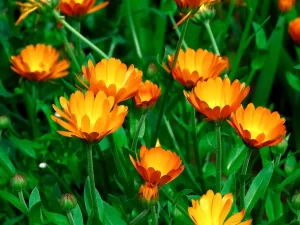
Pot marigolds, often known simply as calendula, are renowned for their bright and cheerful blooms, ranging in colors from vibrant oranges and yellows to soft creams and whites. These marigolds have long been used for their medicinal properties and are known for their skin-soothing and anti-inflammatory effects. Pot marigolds are excellent balcony plants, as they are easy to grow and require minimal care.
They thrive in full sunlight and prefer well-draining soil. With their healing properties and dazzling flower colors, pot marigolds are a valuable addition to any balcony garden, providing not only visual delight but also potential natural remedies for minor skin irritations and ailments.
In conclusion, the different types of marigolds offer a diverse range of sizes, colors, and uses, making them versatile and captivating choices for enhancing your balcony with dazzling flower colors. Whether you choose the grandeur of African marigolds, the charm of French marigolds, the uniqueness of signet marigolds, the flavor of Mexican marigolds, or the healing properties of pot marigolds, each type brings its own distinct allure to your balcony garden.
With their resilience and vibrant flower colors, marigolds undoubtedly add a touch of brilliance and enchantment to your outdoor space, transforming it into a truly dazzling balcony oasis. 🌼🪴
Selecting the Perfect Pot: Best Containers for Thriving Marigolds on Your Balcony
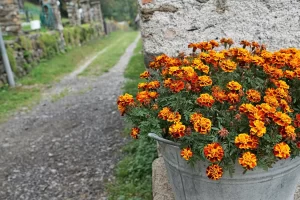
When it comes to cultivating marigolds on your balcony, choosing the right pot is a crucial first step for ensuring their thriving growth. Ideally, opt for containers with proper drainage holes to prevent waterlogged soil, which can lead to root rot. Terracotta pots are an excellent choice, as they provide breathability and allow excess moisture to escape. Additionally, the porous nature of terracotta helps regulate soil temperature, preventing overheating on sunny days. If you prefer a more modern look, consider lightweight plastic or resin pots, which are easy to move around and come in various sizes and designs.
Remember that marigolds prefer slightly acidic to neutral soil, so it’s essential to pick a potting mix that suits their needs. A high-quality potting mix enriched with organic matter and balanced nutrients will ensure optimal growth and blooming. With the right pot and soil combination, you lay the foundation for a spectacular marigold display on your balcony that will dazzle and delight throughout the growing season.
The Essential Soil Mix: Preparing a Nutrient-Rich Blend for Marigold Seeds
Creating the perfect soil mix for your marigold seeds is a vital step in setting the stage for successful germination and robust growth. Marigolds thrive in well-draining soil that provides the right balance of nutrients. To prepare a nutrient-rich blend, start with a high-quality potting mix that is formulated for seed starting. Avoid using garden soil, as it may contain pests or diseases that could harm young seedlings. Complement the potting mix with vermiculite or perlite to enhance drainage and aeration, ensuring that excess water does not accumulate around the roots.
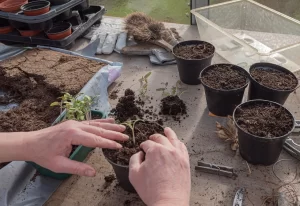
Also, add organic matter such as compost or well-rotted manure to enrich the soil with important nutrients. This organic amendment will also improve soil structure and support beneficial microorganisms, promoting healthier root development. Strive for a slightly acidic to neutral pH level, as marigolds prefer a soil pH of 6.0 to 7.0. By providing your marigold seeds with an optimal soil mix, you give them the best possible start to thrive and bloom vibrantly in your balcony pots.
Sowing Success: Step-by-Step Guide to Planting Marigold Seeds in Balcony Pots
Planting marigold seeds is an exciting and rewarding process that opens the door to a captivating display of colors in your balcony pots. Before sowing, it’s essential to consider the timing of your planting. Marigolds are warm-season annuals that thrive in temperatures between 70°F to 80°F (21°C to 27°C). Therefore, it’s best to sow the seeds indoors 4 to 6 weeks before the last expected frost date in your area. This gives the seeds ample time to germinate and grow into sturdy seedlings before transplanting them to the balcony pots. To sow the seeds, use clean and sterile containers or seed trays with drainage holes. Fill the containers with the nutrient-rich soil mix, lightly tamping it down to create a smooth surface. Moisten the soil gently, ensuring it’s evenly damp but not waterlogged.
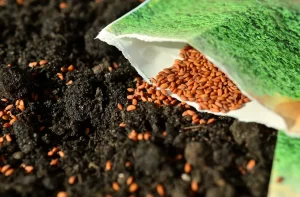
Now, it’s time to sow the seeds. Space them about an inch apart on the soil surface and cover them lightly with a thin layer of soil, approximately a quarter-inch deep. Mist the soil again to ensure even moisture. Cover the containers with plastic wrap or a humidity dome to create a warm and humid environment that aids germination. Place the containers in a warm spot that receives bright, indirect light. Once the seeds germinate and the seedlings have grown a few inches tall, you can transplant them into your balcony pots, where they will continue to dazzle with their vibrant colors and lush foliage.
Watering Wisely: Finding the Right Balance to Nourish Your Marigold Plants
Watering your marigold plants correctly is a key factor in their overall health and vitality. These colorful flowers grow in well-drained soil. Therefore, it is important to find the right balance when it comes to moisture content. Too much water can cause root rot and other fungal diseases, and too little water can cause stress and stunt growth. The key is to provide consistent moisture without allowing the soil to become waterlogged. To determine when it’s time to water, check the soil’s moisture level by inserting your finger about an inch deep into the soil. If it seems dry, it’s time to water it.
For balcony pots, it’s generally best to water in the morning or late afternoon, allowing excess moisture to evaporate before cooler evening temperatures set in. Avoid overhead watering, as it can wet the foliage, making marigolds susceptible to fungal issues. Instead, use a watering can or a drip irrigation system to water the soil directly at the base of the plants. This method ensures that the roots receive the necessary moisture while keeping the leaves dry. As the temperature rises during the hot summer months, you may need to water more frequently to prevent the soil from drying out completely. With wise watering practices, you’ll nourish your marigold plants and witness their colors dazzle and bloom with vitality.
Sunshine and Shade: Understanding Marigolds’ Light Requirements on Your Balcony
For your marigolds to shine brightly on your balcony, understanding their light requirements is essential. These sun-loving plants thrive in full sunlight, which means they need at least 6 to 8 hours of direct sunlight each day to flourish. If your balcony receives ample sunlight, it’s the perfect spot for your marigolds to thrive. However, if your balcony is shaded for a significant portion of the day, don’t fret! Marigolds can still bloom and add beauty to your space with some indirect sunlight. If possible, choose a location on your balcony that receives morning sunlight and dappled shade during the hottest part of the day.
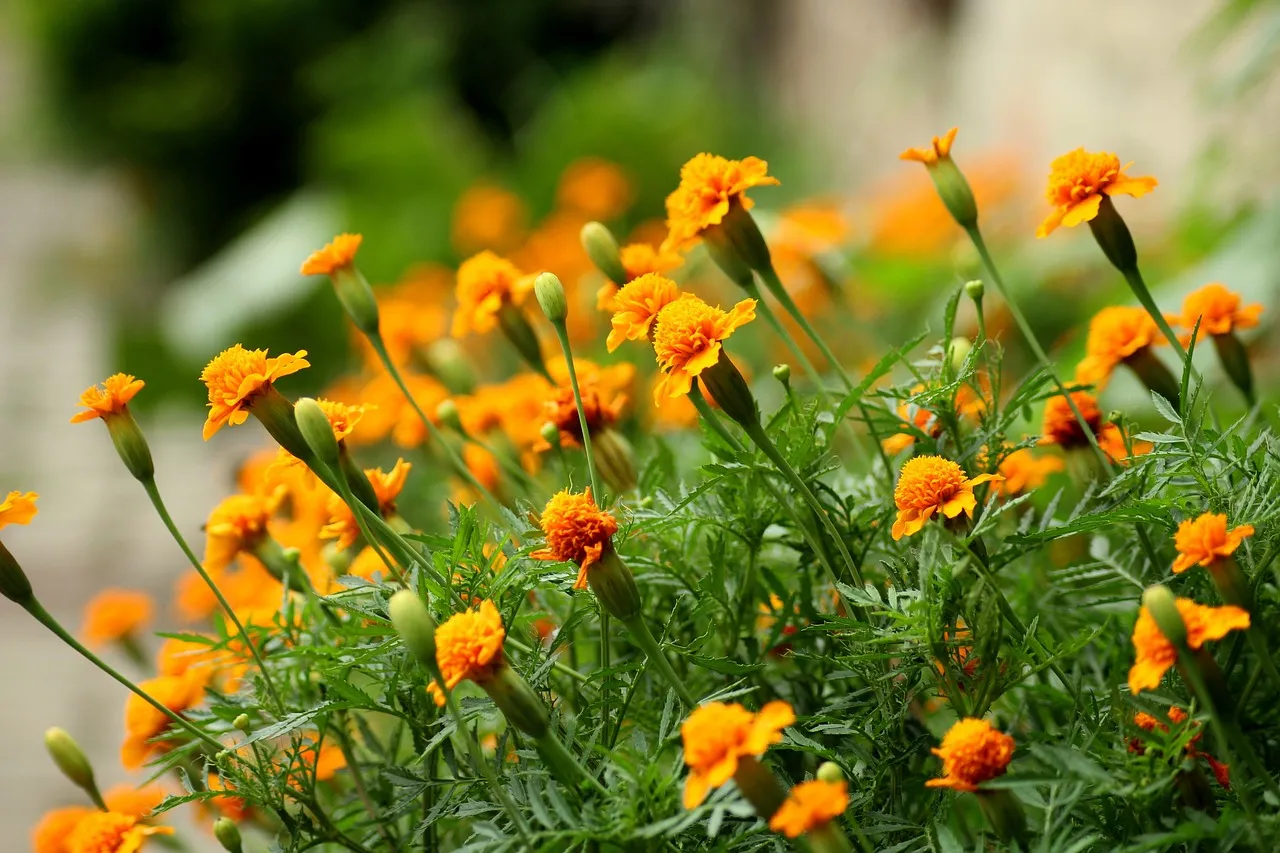
This balance allows marigolds to enjoy the energizing morning rays while being protected from the scorching midday sun. On the other hand, if your balcony is shaded for most of the day, consider selecting marigold varieties that are more tolerant of shade, such as African or signet marigolds. Regardless of the lighting conditions, monitor your marigolds closely. If they begin to stretch or have fewer blooms, it may be a sign that they need more sunlight. By providing the right balance of sunshine and shade, you’ll create an ideal environment for your marigolds to display their dazzling flower colors with radiance.
Growing Up: How to Provide Proper Support for Marigold Stems in Pots
As marigold plants grow, they may need a little extra support to stand tall and proud in your balcony pots. Properly supporting their stems prevents them from bending or breaking due to heavy blooms or inclement weather. For taller marigold varieties, it’s best to insert stakes into the soil early on in their growth journey. Choose stakes that are sturdy and long enough to reach the desired height of your mature marigold plants. As the plants grow, gently tie their stems to the stakes using soft plant ties or twine. Be careful not to tie the stems too tightly, as it can restrict their growth. Instead, allow some room for flexibility while ensuring the stems remain upright.
For shorter marigold varieties, you can create a small trellis using bamboo sticks or garden wire. This trellis will provide subtle support to the plant’s stems while adding a decorative element to your balcony display. The trellis should be installed early in the plant’s growth stage to avoid disturbing the roots later on. By providing the necessary support, your marigolds can confidently reach for the sky, showcasing their vibrant flower colors and creating a dazzling sight on your balcony.
Fertilizing Marigolds: Feeding Techniques for Lush Blooms in Balcony Containers
Feeding your marigolds with the right nutrients is essential for promoting lush blooms and vigorous growth. While marigolds are relatively low-maintenance plants, they do benefit from periodic fertilization to ensure they have the resources they need to dazzle with their vibrant flower colors. The first step is to choose a balanced and water-soluble fertilizer that contains equal amounts of nitrogen, phosphorus, and potassium. This balanced formulation supports overall plant health and encourages robust flowering. Start fertilizing your marigolds when they have established a few sets of true leaves. Apply the fertilizer according to the manufacturer’s instructions, being mindful not to over-fertilize, as it can lead to excessive foliage growth at the expense of blooms.
During the growth season, it is recommended to fertilize every two to three weeks. However, if you notice your marigolds producing abundant foliage but few flowers, reduce the frequency of fertilization to encourage more blooms. Alternatively, you can choose a fertilizer specifically formulated for flowering plants to support an abundance of colorful blooms. By feeding your marigolds appropriately, you’ll enhance their flower colors, creating a dazzling balcony display that captivates all who behold it.
Pest Prevention: Natural Methods to Protect Your Marigolds from Unwanted Guests
As much as we adore marigolds, there are certain unwelcome guests in the garden that share the sentiment – pests. However, fret not! There are natural and eco-friendly methods to protect your marigolds from these unwanted visitors. One of the marigold’s remarkable qualities is its pest-repelling properties, which is why it’s often referred to as a “companion plant.” The marigold’s distinctive scent and compounds act as a natural deterrent against insects such as aphids, whiteflies, and mosquitoes. By strategically planting marigolds among other plants on your balcony, you create a barrier that helps keep these pests at bay.

Additionally, you can make a natural insect repellent spray using marigold leaves and water. Simply steep marigold leaves in hot water for a few hours, strain the mixture, and transfer it to a spray bottle. Spray the mixture on your marigolds and other vulnerable plants to protect them from insect infestations. Ladybugs, lacewings, and praying mantises are beneficial insects that prey on garden pests, including those that may threaten your marigolds. Attracting these helpful creatures to your balcony garden can naturally control pest populations. By harnessing the power of nature’s pest control methods, you can maintain a healthy and vibrant marigold display that is unblemished by unwanted guests.
Pruning for Prolific Blooms: Tips to Enhance Marigold Growth on Your Balcony

Pruning is a valuable technique to enhance the growth and blooming of your marigolds on the balcony. By selectively removing spent flowers and leggy growth, you encourage the plant to channel its energy into producing more blooms. Deadheading, the process of removing faded flowers, prevents the marigold from diverting resources to seed production, allowing it to focus on continuous blooming.
As flowers fade, use clean garden shears or scissors to snip off the spent blooms, cutting just above a set of healthy leaves or buds. Additionally, pruning back any excessive foliage or stems that appear weak or leggy promotes a more compact and bushier growth habit. This method encourages lateral branching, resulting in more flower-bearing stems.
As a result, your marigold plants will be denser and produce a profusion of colorful blooms. Regular pruning also helps improve air circulation, reducing the risk of fungal diseases that can affect the marigold’s health. Remember to sanitize your pruning tools before and after use to prevent the spread of any potential diseases. With thoughtful and timely pruning, your marigolds will flourish and dazzle with an abundance of flower colors on your balcony.
Marigold Repotting: When and How to Upgrade Your Blooming Beauties
As your marigold plants grow and flourish in their balcony pots, they may eventually outgrow their current containers and need more space for their roots to expand. Repotting is the process of transferring your marigolds to larger containers, giving them ample room to thrive and continue dazzling with their flower colors. The best time to consider repotting is when you notice your marigolds becoming root-bound, indicated by visible roots circling the bottom of the pot.
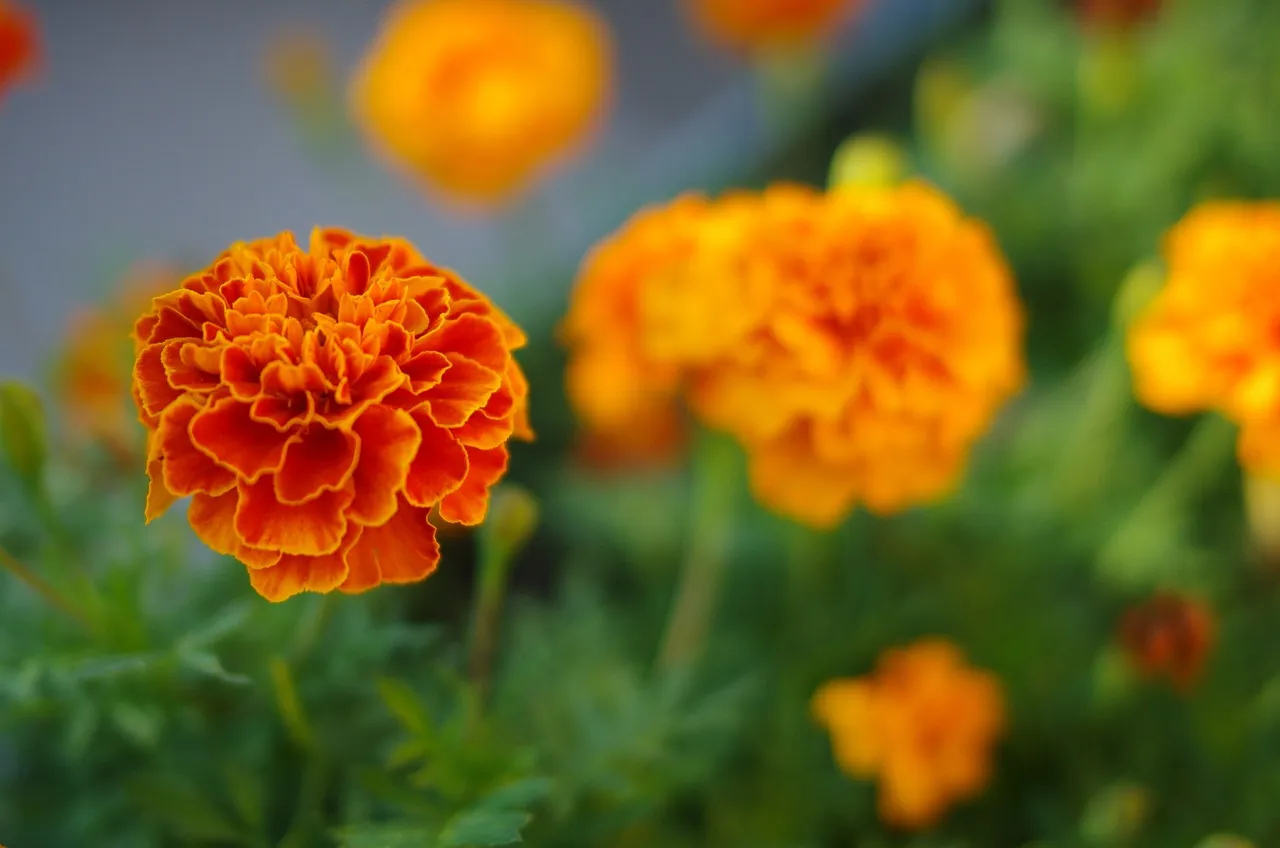
To begin the repotting process, choose a new medium that is 1 to 2 inches larger in diameter than the existing one. Fill the new container with fresh potting mix, ensuring it is at the same level as the soil in the previous pot. Carefully remove the marigold plant from its current pot, taking care not to damage the roots. Gently untangle any circling roots, and if necessary, lightly prune the root ball to encourage new root growth.
Place the plant in the center of the new container and fill the surrounding space with potting mix, gently pressing it down to secure the plant. Water the repotted marigold thoroughly to help settle the soil and hydrate the roots. After repotting, monitor the plant closely for signs of stress, and keep it in a shaded area for a few days to aid in the transition. With a larger space to call home, your marigolds will continue to thrive and enhance your balcony with their dazzling flower colors.
Overwintering Marigolds: Preserving and Reviving Your Balcony Garden Gems
While marigolds are typically grown as annuals, you can extend their beauty by overwintering them in regions with milder winters. Overwintering is the process of protecting and preserving your marigolds during the colder months, allowing them to bloom anew in the following spring. Before the first frost arrives, assess the condition of your marigolds. If they
are still producing abundant blooms and show no signs of disease or pest infestations, consider overwintering them. To begin, carefully dig up your marigold plants from their balcony pots, taking care to retain as much of the root ball as possible. Shake off excess soil and trim any dead or unhealthy foliage. Next, gently wash the roots to remove any remaining soil and trim them to encourage new root growth. Prepare small containers or pots with fresh potting mix, and transplant your marigolds into these containers. Water the plants well to settle the soil and hydrate the roots. Overwinter your marigolds in a cool and well-lit indoor location, such as a basement or garage, where temperatures stay above freezing but remain cool.

Water sparingly during the dormant period, allowing the soil to dry out slightly between waterings. While your marigolds may not produce as many blooms during the winter, they will remain healthy and ready to flourish when the warmer days return. As spring arrives, gradually reintroduce your marigolds to outdoor conditions, placing them in a shaded area for a few days before exposing them to full sunlight. With proper care and preservation, your marigolds will continue to dazzle with their flower colors year after year, serving as enduring gems in your balcony garden.
Marigold Companions: Ideal Plants to Pair with Your Balcony Marigold Display
Enhance the beauty of your marigold display on the balcony by choosing ideal plant companions that complement and harmonize with their vibrant flower colors. Combining marigolds with other compatible plants creates a visually stunning and well-balanced garden space. One classic and time-tested companion for marigolds is the humble basil. Basil repels pests and is said to enhance the flavor of nearby vegetables, making it an excellent choice for a balcony garden.
Additionally, the fragrant leaves of basil provide a delightful aroma that mingles beautifully with the marigold’s distinctive scent. Another fantastic companion for marigolds is the cheerful zinnia. Zinnias come in a variety of colors, and their blooms blend harmoniously with marigolds, creating a captivating tapestry of flower colors on your balcony. Moreover, zinnias attract beneficial pollinators, contributing to a healthy and biodiverse garden ecosystem.
For a touch of elegance, consider pairing marigolds with ornamental grasses such as feather grass or blue fescue. The graceful plumes and delicate textures of ornamental grasses complement the bold and bright blooms of marigolds, adding a touch of sophistication to your balcony garden. Additionally, ornamental grasses sway gently in the breeze, creating a captivating dance of movement alongside your marigolds. When choosing plant companions for your balcony marigold display, ensure they share similar sunlight and watering requirements. With thoughtful pairings, your marigold companions will elevate the beauty of your balcony garden, resulting in a truly dazzling and harmonious display of flower colors.
Troubleshooting Common Marigold Issues: Solutions for a Healthy Balcony Garden
While marigolds are relatively low-maintenance plants, they may encounter a few challenges along the way. By identifying and addressing common issues promptly, you can maintain a healthy and thriving balcony garden filled with dazzling marigold flower colors. One of the most common problems marigolds may face is powdery mildew. This fungal disease appears as a white, powdery substance on the leaves and stems, typically in humid conditions. To prevent powdery mildew, ensure adequate air circulation and avoid overhead watering.
If powdery mildew does occur, treat it with a solution of neem oil or a mixture of baking soda and water. Another issue that may arise is aphid infestations. These tiny insects can quickly multiply and cause damage to your marigolds by sucking the sap from the leaves. To combat aphids, use a natural insecticidal soap or spray the plants with a strong jet of water to dislodge them. Additionally, attracting ladybugs and other beneficial insects to your balcony garden can help keep aphid populations in check. Occasionally, marigolds may develop root rot, particularly if they are overwatered or planted in soil with poor drainage. To prevent root rot, ensure that your pots have proper drainage holes and avoid letting the soil become waterlogged. If root rot is suspected, remove the affected plant immediately and replant with fresh soil in a well-draining container.
Finally, marigolds may experience stress from extreme heat or cold. During heatwaves, provide shade and additional watering to keep the plants hydrated. Conversely, protect marigolds from frost by bringing them indoors or covering them with a frost cloth. By being vigilant and proactive in addressing common marigold issues, you can ensure a healthy and dazzling balcony garden that delights with its colorful blooms throughout the growing season.
Harvesting Marigold Seeds: How to Save and Store for Next Year’s Blooms
As the growing season comes to an end, you can prolong the beauty of your marigolds by harvesting their seeds for the following year. Saving marigold seeds is a rewarding and cost-effective way to continue growing these dazzling flowers on your balcony. To harvest the seeds, allow a few spent flowers on the marigold plants to remain on the plant until they turn dry and brown. These dried flower heads contain the seeds. Once the flower heads have dried completely, carefully remove them from the plant and place them in a paper bag. Shake the bag gently to release the seeds from the dried flower heads. Use your fingers to separate any remaining seeds from the flower debris.
Once the seeds are separated, store them in a cool and dry location in a labeled envelope or small container. Be sure to store the seeds away from direct sunlight and moisture, as these conditions can decrease seed viability. With proper storage, marigold seeds can remain viable for several years, allowing you to sow them anew and continue the dazzling display of marigold flower colors on your balcony. By saving and storing marigold seeds, you not only perpetuate the beauty of these beloved flowers but also nurture a tradition of growing them year after year, creating a timeless and dazzling balcony garden.
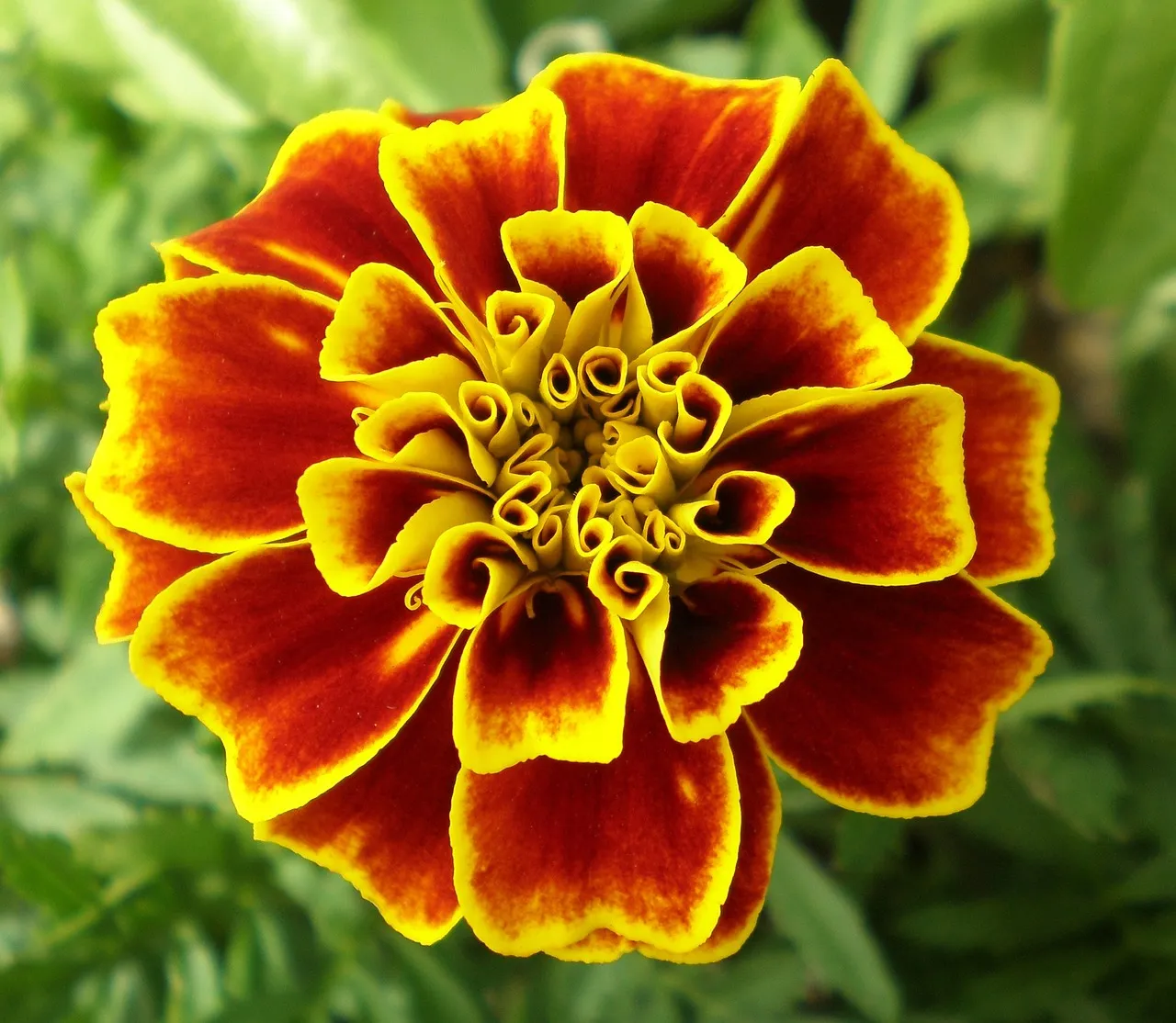
Conclusion
With the enchanting allure of marigold flower colors, your balcony can be transformed into a dazzling and captivating garden space. From selecting the perfect pot and soil mix to sowing and nurturing the seeds, your marigolds will thrive under your loving care. Embrace the sun and shade on your balcony to ensure your marigolds receive the ideal lighting conditions for prolific blooms. Fertilize wisely, protect your marigolds from pests, and prune to promote lush growth and vibrant flower colors.
Consider overwintering your marigolds for a year-round display of their radiant beauty. Pair them with complementary companions to create a harmonious and eye-catching balcony garden. Troubleshoot common issues promptly, and save and store marigold seeds for future blooms. With dedication and admiration for these captivating flowers, your balcony will flourish into a dazzling oasis, showcasing the vibrant and diverse marigold flower colors that fill it with joy and wonder year after year.🌼🪴
Most Frequently Asked Questions on Marigold
Marigolds are one of the most popular and beloved flowers for balcony gardening, and as such, they often generate numerous questions from curious gardeners. In this section, we’ll address the most frequently asked questions about marigolds and provide clear and concise answers to enhance your balcony with these dazzling flower colors.
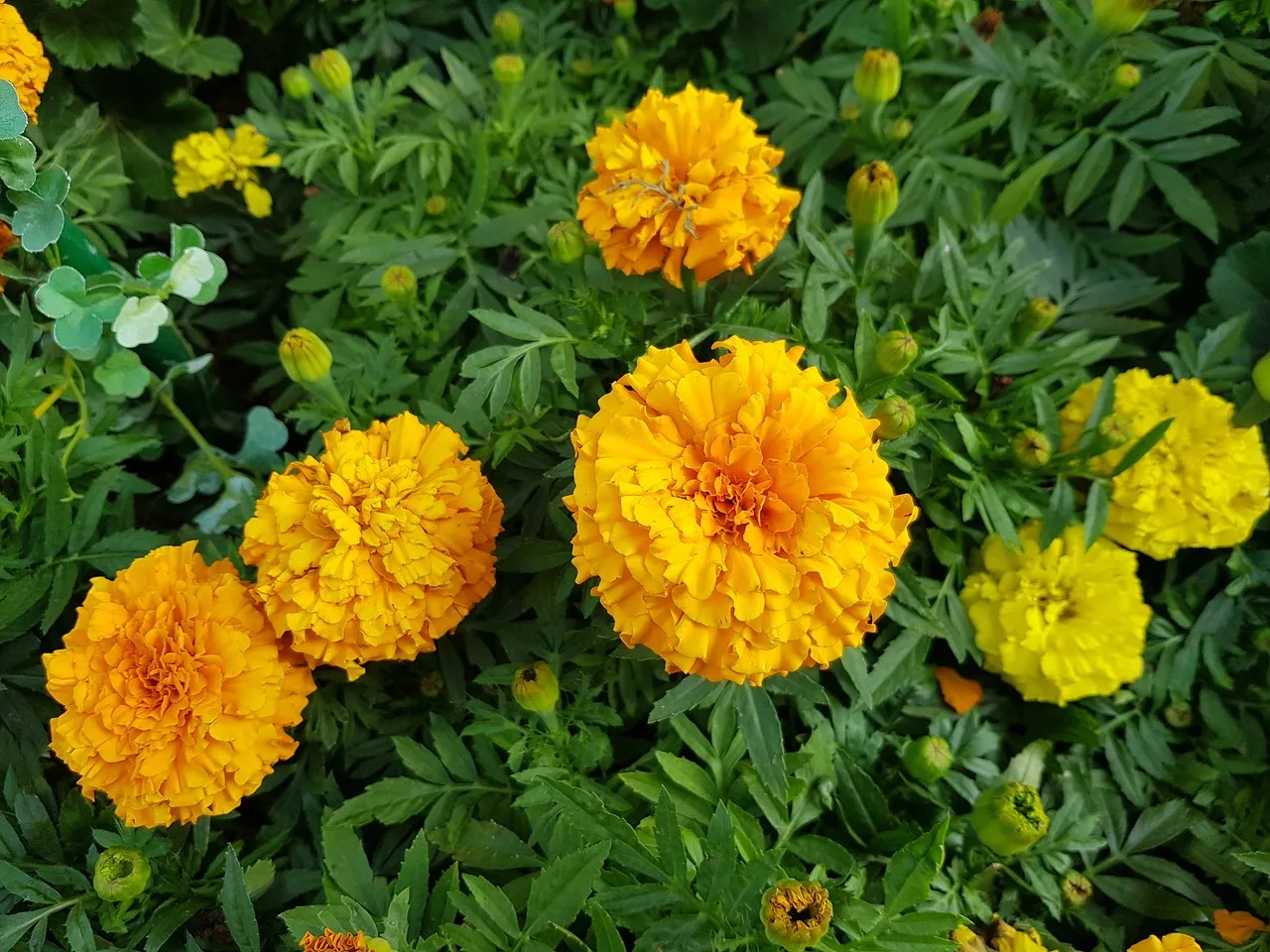
Q1: Can I grow marigolds in containers on my balcony?
Absolutely! Marigolds are well-suited for container gardening on balconies, as they adapt well to confined spaces and can thrive in pots or containers with proper care. Just ensure that your balcony receives enough sunlight for these sun-loving plants to flourish.
Q2: What is the best time to plant marigold seeds in balcony pots?
For balcony gardening, it’s best to sow marigold seeds indoors about 4 to 6 weeks before the last expected frost date in your area. This allows the seeds to germinate and develop into sturdy seedlings, ready for transplanting once the weather warms up.
Q3: Do marigolds require special soil mix for balcony pots?
While marigolds are adaptable to various soil types, they do prefer well-draining soil. To create an ideal soil mix for balcony pots, use a high-quality potting mix and add some vermiculite or perlite to improve drainage.

Q4: How often should I water my marigold plants on the balcony?
The frequency of watering depends on environmental conditions, but as a general rule, water your marigolds when the top inch of soil feels dry. Avoid overwatering, as it can lead to root rot, and water early in the morning or late afternoon to prevent evaporation.
Q5: Can marigolds grow in shade on my balcony?
While marigolds prefer full sunlight, certain varieties can tolerate partial shade. If your balcony receives some sunlight during the day, consider growing shade-tolerant marigold varieties like African or signet marigolds.
Q6: How do I prevent pests from damaging my marigolds?
Marigolds are known for their pest-repelling properties, but if pests persist, you can use natural methods like neem oil or insecticidal soap. Attracting beneficial insects like ladybugs can also help control pest populations.
Q7: Are marigolds toxic to pets or children?
Marigolds are generally considered non-toxic, but it’s essential to keep an eye on curious pets or children to prevent them from ingesting large quantities of the plant.
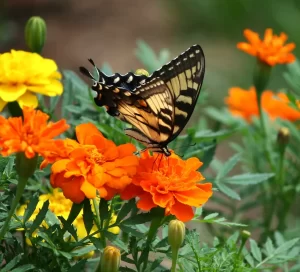
Q8: How do I deadhead my marigolds to encourage more blooms?
To deadhead marigolds, simply remove spent flowers by snipping them just above a set of healthy leaves or buds. This encourages continuous flowering and prevents the plant from transferring energy to seed production.
Q9: Can I save marigold seeds for next year’s planting?
Yes, you can save marigold seeds for the following year. Allow a few flower heads to dry on the plant, then collect and store the seeds in a cool and dry place for future planting.
Q10: How do I overwinter marigolds on my balcony?
In milder climates, you can overwinter marigolds by bringing them indoors to a cool, well-lit location. Reduce watering and provide occasional misting to keep the plants healthy until spring.

With these frequently asked questions answered, you’ll be well-equipped to enhance your balcony with the dazzling flower colors of marigolds. As you embark on your balcony gardening journey, remember that marigolds are not only beautiful but also versatile and relatively easy to care for. Whether you’re a seasoned gardener or a novice, marigolds will undoubtedly add a touch of charm and radiance to your balcony, creating a truly dazzling garden oasis that brightens your days and enchants all who behold it. Happy gardening! 🌼🪴
#BalconyGarden #MarigoldMagic
